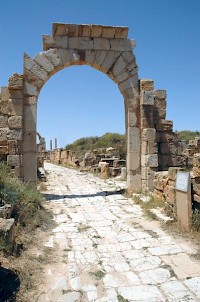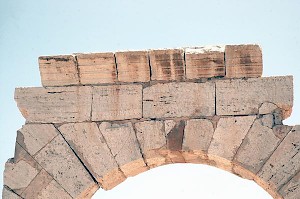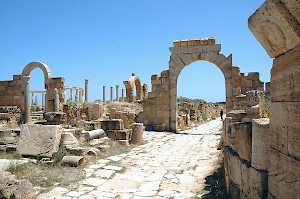Lepcis Magna, Arch of Tiberius
Q21647523Lepcis Magna: Phoenician colony, later part of the Carthaginian empire, the kingdom of Massinissa, and the Roman empire. Its most famous son was the emperor Septimius Severus (r.193-211).

Tiberius was the successor of the emperor Augustus, who had refounded the Roman Empire as a monarchy and had ruled from 27 BCE until 14 CE. Towards the end of Tiberius' reign, who ruled from 14 until 37, the citizens of Lepcis Magna honored their ruler by erecting a modest honorific arch, made of limestone, across the Cardo Maximus, the main street.

The first photo shows the Arch of Tiberius, seen from the northeast. In the distance, the Arch of Trajan can be discerned. It is about a century younger.
In fact, the monument described on this page is only one of two arches dedicated to Tiberius. In a street parallel to the Cardo Maximus (north of the Portico behind the Theater), the remains have been found of a second arch. The explanation for this unusual duplication of the honors may have something to do with the immediate cause of the construction: the paving of the streets surrounding at least two insulae (blocks). It is likely that the zone between the two arches, which included the Chalcidicum and the theater area, was renovated as one single project.

The inscription, on both sides of both monuments, records that the arch was erected during the governorship of Gaius Rubellius Blandus, acting through his deputy Marcus Etrilius Lupercus. (Rubellius Blandus was in charge of Africa in 35-36 CE.) It also informs us that the arch commemorated the paving of several streets, and was financed from the proceeds of land in the interior that had been confiscated from native tribes after the revolt of Tacfarinas (17-24), at the beginning of Tiberius' reign.note